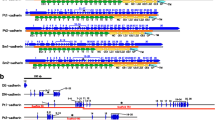Abstract.
The phylogenetic relationships of the kingdom Animalia (Metazoa) have long been questioned. Whether the lowest eukaryotic multicellular organisms, the metazoan phylum Porifera (sponges), independently evolved multicellularity from a separate protist lineage (polyphyly of animals) or whether they were derived from the same protist group as the other animal phyla (monophyly) remains unclear. Analyses of the genes that are typical for multicellularity, e.g. those coding for adhesion molecules (galectin) and adhesion receptors (receptor tyrosine kinase, integrin receptor, receptors featuring scavenger receptor cysteine-rich domains) or elements involved in signal transduction pathways (G-proteins, Ser/Thr protein kinases), especially from the marine sponge Geodia cydonium, indicate that all animals, including sponges, are of monophyletic origin.
Similar content being viewed by others
Author information
Authors and Affiliations
Additional information
Received: 1 April 1997 / Accepted: 10 April 1997
Rights and permissions
About this article
Cite this article
Müller, W. Origin of metazoan adhesion molecules and adhesion receptors as deduced from cDNA analyses in the marine sponge Geodia cydonium: a review. Cell Tissue Res 289, 383–395 (1997). https://doi.org/10.1007/s004410050885
Issue Date:
DOI: https://doi.org/10.1007/s004410050885




